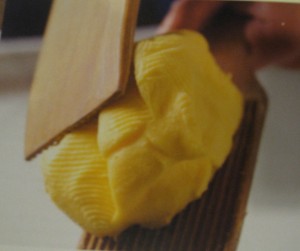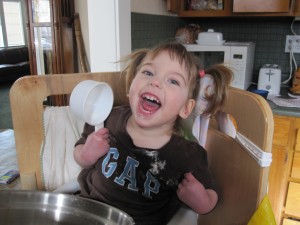
Then Aunt Abigail let her run the curiously shaped wooden butter-worker back and forth over the butter
Wouldn’t Aunt Frances have been astonished if she could have looked in on Elizabeth Ann that very first morning of her stay at the hateful Putney Farm and have seen her wrapped in a gingham apron, her face bright with interest, trotting here and there in the stone-floored milk room!
She was allowed the excitement of pulling out the plug from the bottom of the churn, and dodged back hastily to escape the gush of buttermilk spouting into the pail held by Aunt Abigail. And she poured the water in to wash the butter, and screwed on the top herself and, again all swung the barrel back and forthsix or seven times to swish the water all through the particles of butter. She even
helped Aunt Abigail scoop out the great yellow lumps–her imagination had never conceived of so much butter in all the world!
Then Aunt Abigail let her run the curiously shaped wooden butter-worker back and forth over the butter, squeezing out the water, and then pile it up again with her wooden paddle into a mound of gold. She weighed out the salt needed on the scales, and was very much surprised to find that there really is such a thing as an ounce. She had never met it before outside the pages of her arithmetic book and she didn’t know it lived anywhere else. (from Understood Betsy)
I just couldn’t help sharing one more tidbit from this wonderful book. Imagine learning about ounces and not knowing what they were for or how they were used.
Imagine learning about fractions without being able to apply an everyday use to fractions; not knowing that you need them to make a fabulous pie. What if all they were, were hateful little enemies on a page to cause you dread each day.
Imagine figuring out square footage without understanding that knowing this bit of information would allow you to paint your bedroom a pale butter yellow without running out of paint!
That was math for me, for much of my life. I had a love hate relationship with math. I wanted more than anything to be able to “do” math. That is how it was always spoken of. We needed to learn to “do” math. But it never really meant “do”, it meant memorize and pass a test.
I remember my personal bravery. I had never fared well in math yet I took algebra and geometry in school. In 9th grade I stayed after school every day for help. Finally after two weeks the teacher said in a kind voice, “Mary Ann, your never going to get this; just come to class, be quiet and I will pass you.”
It was almost an exact repeat of that process in 11th grade when I took geometry. In fact, the kindly teacher said almost the same exact words. It has been a sad fact all my life that I struggle to do things that require even some of the simplest math.
Part of the problem is that math was just numbers in a book, to be memorized and then tested. It didn’t apply to anything real. I couldn’t move the concepts from the page to the life I actually lived. It was just so much stuff to memorize so that you knew you were smart and fit in with the other kids.
But what about story problems, that is how we let kids know that math is used every day in real life, right? Here is how I and most of my friends viewed story problems. They were a trap. They were filled with unnecessary information to trip you up. They were designed to test your ability to discern what was important and what wasn’t. I would break into a sweat whenever I had to face a story problem. How in the world could I manage to think of it as anything real? It was a nightmare.
I propose that teaching math works best when we use it in everyday life, like Betsy did to salt the butter. I finally learned about fractions when I became a baker as a girl. Thats when I recognized the uses of math in cooking. Pies were my specialty and I made a lot of them. Fractions became friends to help me out.
Carpentry can teach many algebra and geometry skills without ever labeling them as such( Teaching basic Math and Geometry with Carpentry). Sewing is a magnificent way to teach math skills, as well as crochet and knitting( Teach math to kids,the fun way). Shopping is wonderful. Help your children figure out the best deal on products. Help them figure out if they have enough money for two candies or just one. These are all simple applications of maths in real life.
I know that we have to understand how to add and subtract. We need to memorize those pesky multiplication tables. We need to be able to divide. Begin teaching these math concepts to your children when they are very young.
When I bake with my 4 and 2 year old grandchildren I talk to them. “Ok, we need one cup of flour. This is a whole cup. Now we need ½ cup of butter. So we need only ½ of this cup. We need 1 teaspoon of vanilla but we are making two batches of cookies so 1 and 1 makes 2. We need 2 teaspoons of vanilla. Do they understand? No. But they will. They will learn how to “do” fractions.
A real life, “I am doing it” problem is the best story problem
Please share this real life math article with others and share your real life math experiences in the comment section below. They will help and inspire others.
Possibly Related Posts:
- 5 Creative Writing Exercises for Kids of All Ages
- 5 Ways to Help Your Child Think Like a Scientist
- Inspiring Learning
- Family Philanthropy Project – How to Grow Your Family’s Heart by Jodie Palmer
- Science of making Ice cream with liquid nitrogen







{ 2 comments… read them below or add one }
Your experience with math sounds eerily similar to mine! This is why, as a teacher, when I discovered Waldorf math gnomes I was so upset that other children (non-waldorf) were robbed of the opportunity to learn math concepts so gently. Email me your address and I will send you a set of Arithmetic Village books for your grand children. (and you 🙂 )
Oh Kimberly, this is so wonderful of you. One of my goals in this life is to be able to understand and teach the basic math concepts without breaking into a cold sweat. You are a darling for sure.